
Columbia, 15 Chapters, 1940. Starring Don Douglas, Lorna Gray, Harry Harvey, Jack Ingram, Marin Sais, Forrest Taylor.
A group of prominent citizens of the Dakota Territory boomtown of Deadwood are trying to bring the railroad to their area to help their bid for statehood–but the Skull, a mysterious outlaw leader who plans to rule the Territory, is equally determined to keep out the railroad and thwart the statehood campaign. Famed gunslinging marshal Wild Bill Hickok (Lane Chandler) is brought to Deadwood to help clean out the Skull’s gang, but is murdered by Skull henchman Jack McCall (Karl Hackett). However, the killing of the marshal prompts Deadwood newspaper editor Dick Stanley (Don Douglas)–a former gunfighter and a friend of Hickok’s–to strap on his guns again and battle the outlaws as the masked avenger Deadwood Dick; he must not only defeat the Skull’s followers, but also discover which respected member of the Statehood for Dakota Committee is secretly the Skull himself.
Most of director James W. Horne’s Columbia serials are disjointed mixtures of farce and standard serial action–but Deadwood Dick manages to “click” as an exciting and effective chapterplay, despite being helmed by Horne. The serial still contains some of the director’s characteristic touches–particularly when the Skull is browbeating his men for their failures–but the self-parodying elements are much more muted here than in any other Horne outing, allowing the serial’s good location shooting, interesting script, and solid action scenes to occupy center stage.
The serial’s writers–George Plympton, Wyndham Gittens, Morgan Cox, and John Cutting–make clever use of genuine Old West events to launch their narrative, boldly assigning responsibility for the historical assassination of Hickok to their fictional Skull. By allowing the heavy to slay such a legendary frontier figure, the writers firmly establish him as a truly formidable menace to law and order in the West, giving him a menacing aura that persists throughout the serial, despite the character’s occasional irritable rants. The added interest that this incorporation of real-life events gives to the action also persists in subsequent chapters, when the storyline shifts into more standard plotting territory.

Above: Lane Chandler’s Wild Bill Hickok (white hat) draws the famed “Dead Man’s Hand” in a poker game with Jack Ingram.
Once Hickok’s murderer Jack McCall, who soon becomes the target of both heroes and villains, is killed off in Chapter Three, the serial changes its focus to the fight over the railroad–with Deadwood Dick thwarting the Skull’s payroll thefts, legal frauds, and other railroad-damaging schemes, while the Skull lays continual plots aimed at the destruction of his antagonist. This scenario provides sufficient material to keep the action moving nicely for fifteen chapters, with additional subplots–the heroine’s undercover stint as a waitress, the red-herring behavior of the Skull suspects, the arrival of a phony marshal, the framing of the hero for murder–serving to mask the repetitious aspects of the plotting.
The writers also pen plenty of sharp dialogue–although, knowing director Horne’s penchant for contributing to scripts, some of the lines were probably his own work. While I could do without some of the Skull’s outrageously sarcastic put-downs of his henchmen, or his furious reaction to an editorial that casts doubts on his sanity, other bits are funny without undermining suspense–Jack McCall’s dialogue during the stage robbery, the Skull’s amused quip when he thinks that the heroine (actually, Deadwood Dick himself) is knocking his henchmen around the hideout’s upstairs rooms, or the many interchanges between the peppery Calamity Jane and rascally newspaper printer Dave Miller (the “first prayer” scene is particularly good). In fact, in Dick Horne seems to confine most of his comedy touches to the comic relief characters (Jane and Dave), which not only allows the villains to preserve some of their dignity but also makes said comic relief much funnier than the serial norm (Horne, after all, knew comedy far better than most chapterplay directors).
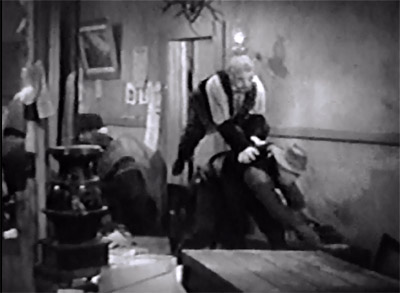
Above: The awkward but feisty Dave Miller (Harry Harvey) jumps a newspaper-wrecking outlaw.
The action scenes are unusually good for a Columbia of the period; there are still some of the hero-versus-four-or-five-henchman fights that Horne delighted in, but such brawls are far better-staged than usual in Horne’s serials. The presence of Yakima Canutt–in one of his only Columbia serials–as Don Douglas’ double undoubtedly accounts, at least in part, for the improved action; sequences like the Chapter Nine restaurant fight, the Chapter Eleven fight in the newspaper office, or the suspenseful last-chapter tunnel fight (as Dick tries to keep the Skull from wrecking a locomotive) are very smoothly and entertainingly staged. Chuck Hamilton and Wally West, two of Columbia’s stunting standbys, contribute to these scenes as well.

Above: Deadwood Dick battles the Skull’s men atop a moving freight car in Chapter Five.
Canutt, along with his fellow cowboy-stuntman Cliff Lyons, also turns in some good riding scenes–with help from director Horne, whose camera angles show off the outdoor scenery of Iverson’s Ranch to very good advantage. The Chapter Five pursuit of the hero’s buckboard–and the buckboard’s subsequent crash–is particularly well-shot; the Chapter Four horseback chase is also good, as is the very lengthy trailing/chase sequence in Chapter Twelve. Other action highlights include the shootout and fight at the mine in Chapter Eleven, the large-scale attack on the railroad’s supply wagons in Chapter Three, and the excellent Chapter One tussle between Dick and Jack McCall on a runaway railroad handcar.
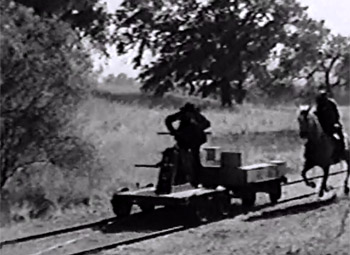
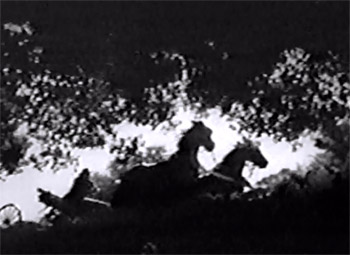
Above left: Deadwood Dick catches up to Jack McCall just before the handcar fight scene. Above right: A neat shot from the Chapter Five chase sequence.
The handcar sequence also leads into a very good chapter ending, with the explosive-laden vehicle and its riders flying off a cliff. This cliffhanger sets the tone for most of the serial’s other chapter endings, which are generally spectacular and only occasionally resolved in the “live-through-it” style common to both Columbia and Universal serials; the best of the group is the Chapter Twelve ending, in which the heavies roll a flatcar into a shack occupied by the hero and send the whole building off a cliff. The burning-building cliffhanger in Chapter Four and the stampede cliffhanger in Chapter Nine are excellent too, although according to the reminiscences of heroine Lorna Gray, they were filmed with a rather reckless indifference to the actors’ safety.

Above: The handcar plummets from a cliff at Iverson’s in the Chapter One cliffhanger.
The serial’s performances are lively and decidedly hammy at times, but the boisterous acting actually seems to mesh well with the larger-than-life, dime-novel Western atmosphere of the chapterplay. Don Douglas, who specialized in playing slick lawyers in feature films, is an odd choice for a Western hero, but actually does quite well here; his extremely glib, fast-talking manner makes him seem slyer and more intelligent than the average serial protagonist. He’s likably chipper in interchanges with the sidekick or the heroine, and carries off Dick Stanley’s mild-mannered editor pose well–but successfully assumes a much tougher bearing when confronting the heavies as Deadwood Dick, aggressively and authoritatively barking at henchmen to drop their guns.

Above: Don Douglas doffs his Deadwood Dick mask.
Lorna Gray looks exceedingly beautiful throughout as heroine Ann Butler (the sister of a reporter murdered in the first chapter). Her acting is very energetic, whether she’s bantering with the hero or angrily defying the heavies, but she retains her characteristic gracefulness in all her scenes and never descends into the irritating shrillness or petulance displayed by Nell O’Day, Dorothy Short, and some of Horne’s other leading ladies.
Harry Harvey, usually a much more low-key actor, is exuberantly quirky as the crotchety, uncouth, and amusingly self-confident Dave Miller–swigging whiskey, feistily exhorting Don Douglas to “start-a-shootin’ it out with them varmints,” lending his unrequested presence to committee meetings, or bickering with the equally cantankerous Calamity Jane. Former silent star Marin Sais is also very good as Calamity, providing plenty of humor with her pugnaciously colorful frontier dialogue but also giving her character some depth through her bitterly angry reaction to Bill Hickok’s death.
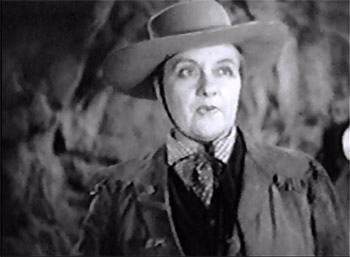

Above left: Marin Sais. Above right: Harry Harvey.
Forrest Taylor provides the voice of the Skull, making the character sound cunning, malevolent, and slightly insane; his sinister laugh is particularly effective. Sometimes Taylor overacts, as in the abovementioned editorial-reading scene, but overall the combination of his voice with the black-cloaked villain’s striking visual appearance makes the Skull one of Columbia’s most memorable masked heavies; he looks particularly menacing when stalking into his hideout or using a rifle to knock off enemies from a distance (the music cue that accompanies his entrances accentuates his menace, suggesting as it does a cold wind blowing out of a cave).
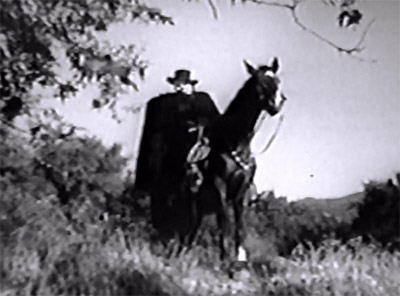
Above: The Skull takes aim at an off-camera Deadwood Dick.
Jack Ingram, as action heavy Buzz Ricketts, is sometimes sinister in his characteristically sardonic way (as when ordering his followers to kill the heroine), but in other scenes is far too jumpy and diffident in manner, fiddling nervously with the drawstring of his hat in Oliver Hardy fashion. Comedian Kit Guard, on the other hand, plays things completely straight as another leading henchman, in an effectively tough performance light-years removed from his turn in The Green Archer. As other prominent outlaws, veteran screen badmen Tom London, Al Ferguson, and Charles King keep their performances mostly comedy-free as well.

Above: Karl Hackett (left) and Jack Ingram.
Horne regular Constantine Romanoff is another member of the henchman pack, but remains mostly in the background (he does have one priceless line when glowering disapprovingly at a citizens’ vigilance committee). Kenne Duncan plays a minor outlaw role, and Roy Barcroft makes a welcome appearance as a phony marshal, giving the part all his usual gusto. Karl Hackett is very good as the slimy and audacious Jack McCall in the early episodes, and Murdock McQuarrie is highly entertaining (if decidedly hammy) as an outrageously shifty shyster who files a phony suit against the railroad. Fred Kelsey, the blustering comic cop from Horne’s Green Archer, has a surprisingly ordinary part as a crooked bartender.
The Skull suspects on the Statehood for Dakota Committee are played by Edward Cassidy (the banker), Robert Fiske (the lawyer), Edward Peil (the rancher), Lee Shumway (the railroad man), Edward Hearn (the stageline owner), and Edmund Cobb (the mine owner). All six of these solid character players do a fine job, with Cobb’s doggedness, Fiske’s combination of furtiveness and aggressiveness, and Hearn’s grandiloquent outrage making the strongest impression. Lane Chandler is terrific as Wild Bill Hickok; his swaggering but good-natured confidence is so appealing and so infectious that his death comes as a real shock.
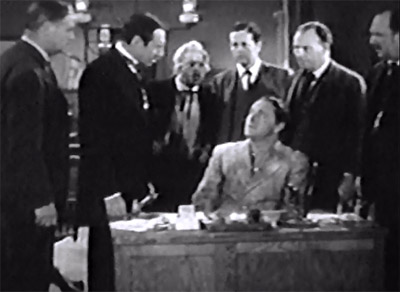
Above: The Committee members receive a disappointing report from a seated Don Douglas. Standing, left to right, are Edward Hearn, Robert Fiske, Harry Harvey, Edmund Cobb, Edward Peil, and Ed Cassidy.
Bud Osborne, for once, gets to play a friendly and helpful stage driver and not a henchman pack member, while Joseph Girard pops up as a judge. Fern Emmett plays a female heavy who gripes comically about the stress of guarding the captive heroine, and Yakima Canutt has a bit as an outlaw. The youthful actor cast as the fatally inquisitive reporter Tom Butler is not identified either in the serial’s credits or on the frequently unhelpful Internet Movie Database; like most such mystery players, he makes me think that he’s someone I should recognize.
With a less eccentric director at the helm, Deadwood Dick could have been Columbia’s greatest Western serial–but Horne’s work on the chapterplay is pretty strong nonetheless. For once, he emphasizes adventure and excitement over his usual tongue-in-cheek quirkiness, and delivers a serial that can be thoroughly enjoyed as a serial, not merely as an amusing but uneven mélange of action and comedy.


Good revue as always. Just the fact that this is another opus helmed by James Horne makes me walk,no run away from this Columbia epic. No rating since I havent seen the serial.
Jerry,
Another great review and personally I think this is the best Western serial Columbia ever made. I know a lot of people either rate The Great Adventures of Wild Bill Hickok or Overland with Kit Carson as the best Columbia western serial but Deadwood Dick had the best story, action and chapter endings. And for once Horne forgot he wasn’t directing a Laurel and Hardy comedy but was directing a serial. Don Douglas would not have been my choice for the role of Dick Stanley/Deadwood Dick but he was alright. I was really impressed with the large cast of western regulars i.e. Roy Barcroft, Charlie King, Kenne Duncan, Yak Canutt and Columbia standby Jack Ingram to name a few. Just a great serial………………………..
Barcroft
This is one I find less than the sum of its parts and falling short for me. It has a terrific villain and a top cast of the best B western performers of the era. Lorna Gray has a winning personality as the leading lady. Both Marin Sais as Calamity Jane and Lane Chandler as Wild Bill are memorable. There is plenty of action and the production values are good. So why don’t I like it that much? I can give a couple of reasons, but there is also one can’t quite put my finger on. The reasons I can articulate are Don Douglas as the hero. It just doesn’t cut it for me. He just strikes me as too wimpy to be the fastest gun and best rider in the west, and all that. Harry Harvey I found annoying in his overacting. I wasn’t as impressed by the “live through it” cliffhangers as some are. While the Skull was an imposing villain, I thought his openly callous treatment of his henchmen was not terribly realistic. No one could pay me enough money to treat me like that.
The one I can’t quite put my finger on probably comes down to Horne’s direction. There is lots of riding around and fighting and shootouts. The action is frenetic. But it never seemed to involve me like Republic does, despite obviously good stunt work. I think I just don’t find Horne that good at action scenes. *** out of ***** stars, but this one had the potential with a different director and star to be right at the top.
Another well-balanced and thoughtful review. I found this serial to be very enjoyable from beginning to end, with a great cast, especially among the supporting players, many good performances and some first-rate action. Horne’s work certainly provokes many negative opinions, but I find his serials to a nice change of pace from the usual fare. My only real complaint is that I wish Lorna Gray had been given more to do.